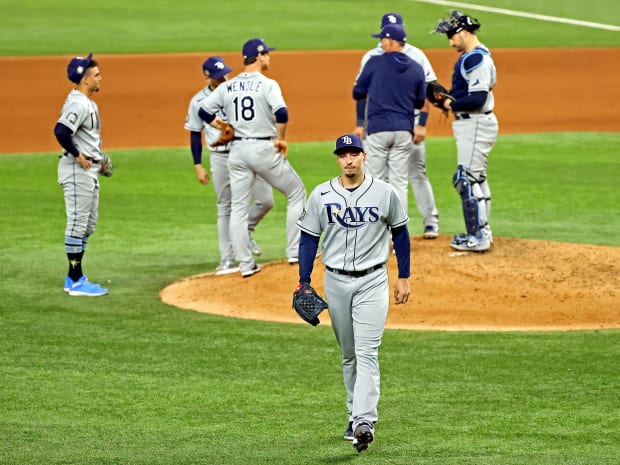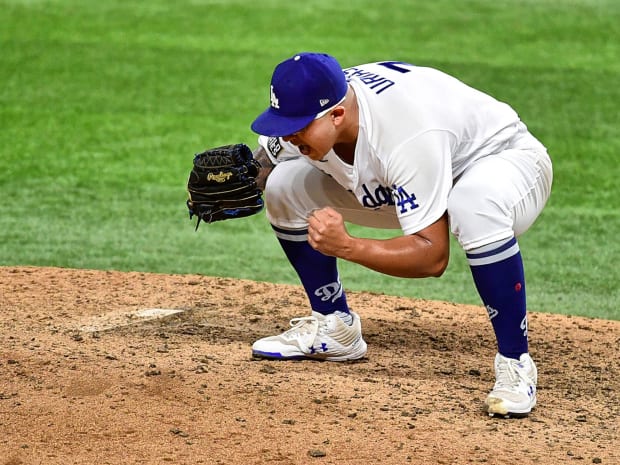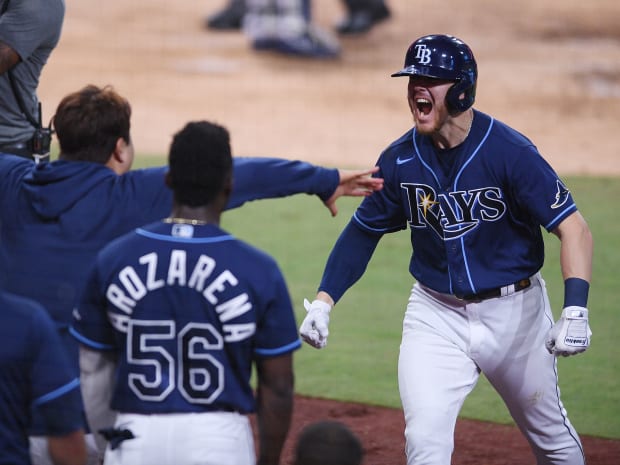New on Sports Illustrated: What Was Behind Rays' Disastrous Game 6? A Lack of Trust
In one isolated moment, Kevin Cash did not trust a left-hander against Mookie Betts, when the numbers suggested he should.
On the eve of World Series Game 1, I held a conversation with Rays GM Erik Neander about how to interpret sample size in a pandemic season. The subject: Mookie Betts vs. left-handed pitchers. I never thought the World Series would swing on that conversation.
The Braves during the NLCS had made me aware of Betts’ weakness against left-handed pitchers.
“The Dodgers are interesting because they have a lot of right-handed hitters who are better against right-handed pitching,” Atlanta bench coach Walt Weiss said. “Have you looked at Betts’s numbers? He’s one of the worst hitters in the league against left-handed pitching.”
Sure enough, Betts had the worst slugging percentage against left-handed pitchers of any hitter in the majors in 2020 (.218, minimum 50 at-bats). He confirmed his weakness in the NLCS, going 1-for-13 against Atlanta left-handers.
On the workout day before the World Series, I asked Neander how the Rays would act on that intelligence when Betts came to the plate in a big spot.
“Are you bold enough to bring in a lefty to face Mookie Betts?” I asked him. “It seems counterintuitive on the face of it, but the data shows you should. Have much faith do you put in the data?”
Said Neander, “We’ve seen it. It’s there. It’s a good question and we’ve discussed it. I will say especially with [left-handed Corey] Seager behind him, it does make you think about using a lefty on Betts.”
In the sixth inning of Game 1, the Rays did bring in a lefty, Josh Fleming, to face Betts. Betts hit his first pitch for a home run. He saw Fleming again in the eighth and smacked a single at 107.5 mph, the hardest hit ball of the World Series by Betts.
Did those Game 1 at-bats get Tampa Bay off the idea of using lefties against Betts? They should not have. Talk about small samples. Two at-bats?
Besides, over his next six at-bats in the World Series against Tampa Bay lefties, Betts went 0-for-6: three strikeouts and three weakly hit outs. Against Blake Snell he was 0-for-4: three strikeouts and a soft roller to third.
That brings us to the sixth inning of World Series Game 6. The Rays led, 1-0. Betts was due to face Snell with a runner at first and one out, with Seager behind him. How good was Snell? He was the first pitcher in World Series history with nine strikeouts and no walks in less than six innings. It was an all-time great pitching performance in the making. He had thrown 73 pitches.
He had dominated Betts. He had owned Seager (1-for-5, three strikeouts).

I saw Rays manager Kevin Cash run out of the dugout. That usually is a signal to the pitcher, “Don’t shut down. This is just a visit, not a pitching change.” But Cash ran to the mound to take him out. Unbelievable.
Cash later said Snell had “done his job,” an insult to a Cy Young Award winner, not some fifth starter. Cash leaned on the “third time around” trope, which holds that a pitcher loses effectiveness when facing hitters a third time in a game. In the universe of all pitchers and all hitters, it is true. It’s a good rule of thumb. And only four other managers let their starters face hitters a third time less than Cash did this year.
But the narrowness of such thinking in the moment was stunning. The awareness of how Snell was throwing, how he had dominated Betts, how Betts had struggled all year against lefties, how Seager was on deck … all of the real time information lost out to the large sample percentages.
Taking Snell out may have been the wrong call. Taking him out in favor of Nick Anderson was even worse.
Anderson was one of the best relief pitchers in the regular season. But his stuff in the postseason deteriorated with heavy use. Before Game 3, Cash admitted that the workload in October was taking a toll on the life on his fastball.
“Partly that’s on me,” Cash said. “Asking him to pitch two and two-thirds innings is not helping him. When he’s right, hitters can’t get to his fastball at the top of the zone.”
Cash asked Anderson to pitch more than one inning only once in the regular season. He asked him to do it seven times in nine postseason games over 26 days. Batters hit .097 against Anderson’s fastball in the regular season (3-for-31). But as he tired in the postseason and could not spin the pitch at the top of the zone above barrels, they hit .270 against it entering Game 6 (10-for-37). He had given up runs in six straight postseason appearances.
After Betts saw Snell leaving and Anderson entering, he looked at Dodgers manager Dave Roberts and grinned. Nothing needed to be said. Cash had made Betts happy. He had just replaced a hot pitcher who had dominated Betts with a cold, tired one who was exactly the type of pitcher Betts most loved to hit against: a right-handed fastball pitcher.
Against right-handed four-seam fastballs to that point, Betts was slugging .667, the fourth best mark in baseball (min. 60 at-bats). The No. 2 slugger against right-handed fastballs was right behind him, Seager (.859).
Six pitches later, the World Series was over. Betts ripped an Anderson fastball for a double. Anderson bounced a curveball for a wild pitch to allow the tying run to score. Seager grounded softly to first, where Ji-Man Choi did not charge the ball. Betts beat the throw home for the series-deciding run.
The decision by Cash will rank among some all-time postseason head scratchers by managers. Matt Williams pulling Jordan Zimmermann. Buck Showalter not using Zack Britton. Bobby Cox bringing in Charlie Leibrandt to pitch to Kirby Puckett. Tommy Lasorda pitching to Jack Clark. This one happened in a World Series elimination game.
Snell should have remained in the game. But if you are driven by third-time-around logic, then the better choice for Cash was lefty Aaron Loup instead of Anderson. Yes, your best lefty for Betts, with Seager behind him. Loup had allowed a run only once in 14 appearances since Sept. 11. Betts had not faced him in two years.
This was not a case of analytics vs. observation. That narrative is so hackneyed. The media love to present the issue as sides of a coin. Nobody makes decisions entirely on one or the other. Every team blends the two. The question is never either/or but rather how you balance what you know and what you see.
The Rays did not lose the World Series because they were too wedded to analytics. They got there precisely because they blend them so well with traditional scouting and development. In one isolated moment, Cash did not trust a left-hander against Betts, when the numbers actually suggested he should do so. It was a moment Neander and the Rays knew was coming.

Understanding Urías
Dodgers pitcher Julio Urías threw 1,215 pitches this year. The fastest one he threw was his last: a 96.7 mph fastball that Willy Adames took for a called third strike for the last out of the World Series.
On Sept. 17, Urías took the mound against Colorado as a different pitcher. He had walked four batters in his previous start. Dodgers pitching coach Mark Prior suggested he junk the windup and go to the stretch position with nobody on base. Prior correctly had diagnosed that as Urías began his windup the rotation of his shoulders differed from pitch to pitch. By pitching from the stretch, Urias could keep his shoulders aligned to the plate consistently.
After Prior suggested the change, Urías went 4-0 with one save and a 1.04 ERA in eight games. He walked only six batters while striking out 36.
The benefits included more arm speed to sell his changeup and to spin his breaking ball. The velocity on Urías’s curveball shot up from 80.2 before the change to 82.2 after it. The batting average against the pitch dropped from .200 to .140 after the change.
World Series titles are built on clutch performances. But don’t ever forget the work of coaches behind those performances.
A Blistering Fastball
Now it can be told: Walker Buehler used low-level laser light therapy to manage the blisters on his index and middle fingers.
“Every day, only about five to 10 minutes a day,” Buehler told me.
Buehler also used Stan’s Rodeo Ointment, the homemade concoction of former Dodgers trainer and rodeo cowboy Stan Johnston. The stuff smells like a medicine cabinet and looks like thick, black goo. It’s the same stuff Josh Beckett used to conquer his blister issues to win the 2003 World Series. At about $35 an ounce, it’s more expensive than silver.
The job by the Dodgers training staff cannot be overlooked here. Buehler’s work and pitch selection had been limited by the blisters in September. One blister opened up during his NLDS start against San Diego when facing his penultimate hitter in that game. Buehler found blood on the baseball after a hit by Austin Nola. Manager Dave Roberts had to have a bulk reliever ready behind Buehler in case the blister forced an early exit.
But the training staff helped Buehler turn the blisters into a non-issue. Buehler threw his best baseball of the year in the postseason, especially when it came to his fastball.
Buehler has an extraordinary fastball in the key pitch characteristics, such as velocity, spin and carry through the zone. He allowed the lowest slugging percentage on four-seam fastballs this year–a ridiculously low .119 mark (minimum 300 fastballs). His fastball played up even more in the postseason.
Buehler explained that his arm strength improved after the Dodgers slow-played him coming out of an abbreviated summer camp and that the postseason baseballs were different than the regular season baseballs.
“The seams were lower,” he said. “I don’t have big hands, so the lower seams allow me to my fingers around the ball more.”
Before this postseason, Buehler never had spun his fastball at an average of 2,700 rpms in any game in his career. He did it in both of his last two postseason starts. Only Trevor Bauer reached that level of spin the entire year (min. 50 fastballs in a game).
The three best fastball spin rates of Buehler’s career all came in this postseason. Check out how Buehler conquered the blister problems to put more and more backspin on his fastball:
Buehler Average Game Fastball Spin Rate, 2020

The Yankee-Killer’s Exclusive Weapon of Choice
Did you notice that Mike Brosseau was using a different bat in the World Series than the one he used to hit that
game-deciding home run off Aroldis Chapman in the ALDS? The one he used until Game 6 was natural wood color. The home run bat was black. What gives?Here’s what Brosseau told me:
Back on August 19, he suddenly was called on to pinch hit in a game against the Yankees. He had so little time to prepare that he just reached for any one of his bats from the rack. He happened to grab a black one. Brosseau got an RBI single off Britton.
The next day, and for the rest of the season, he went back to his usual bat.
He didn’t use the black one again until ALDS Games 4 and 5. He figured if it worked against the Yankees once, why not try it again?
He struck out against Chapman in Game 4 but hit that memorable home run with it in Game 5 to eliminate the Yankees.
Someone from the Hall of Fame placed a call to the Rays clubhouse after the game. They asked if Brosseau would like to donate his bat to the Hall.
The clubhouse manager relayed the request to Brosseau.
“Are you kidding? Sure.”
“But Mike,” the clubbie said, “don’t you want to keep using that bat first?”
“No,” Brosseau said. “That’s my Yankee bat. We’re done with the Yankees.”
So Brosseau’s black bat–used only against the Yankees–is now in the Hall of Fame. Not bad for a guy from Oakland University who signed as an undrafted free agent in 2016.
“Can you believe it?” he said. “That is the coolest honor I’ve ever been given. Just goes to show you how this game can give you incredible opportunities.”
Mookie’s Tribute
Before his first at-bat of every game Mookie takes the knob of his bat and draws the initials “EC” in the dirt around home plate. It is a tribute to his late grandmother, Etta Collins.
“She was my best friend growing up,” Mookie said. “She would always make deals with me. She was on dialysis, and she would say, ‘If you get me some water you won’t have to do your homework.”
Etta Collins passed away when Mookie was 10 years old. He started the tradition of drawing her initials before his first at-bat back in high school and has been doing it ever since.
“High school, minor leagues, World Series, every game,” he said.
Comments
Post a Comment